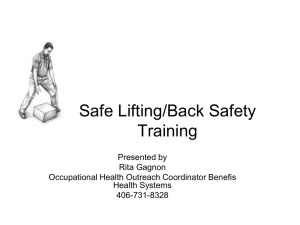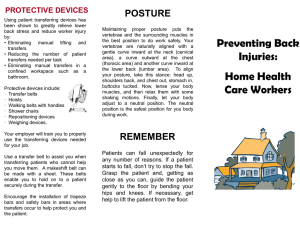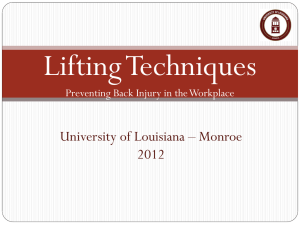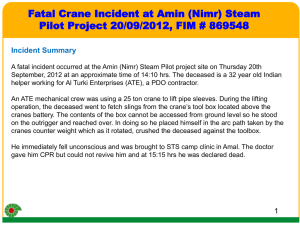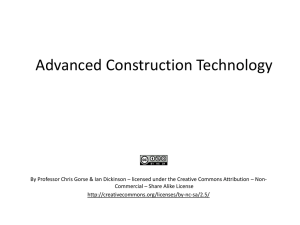Terre Hill Concrete Lifting Devices
advertisement
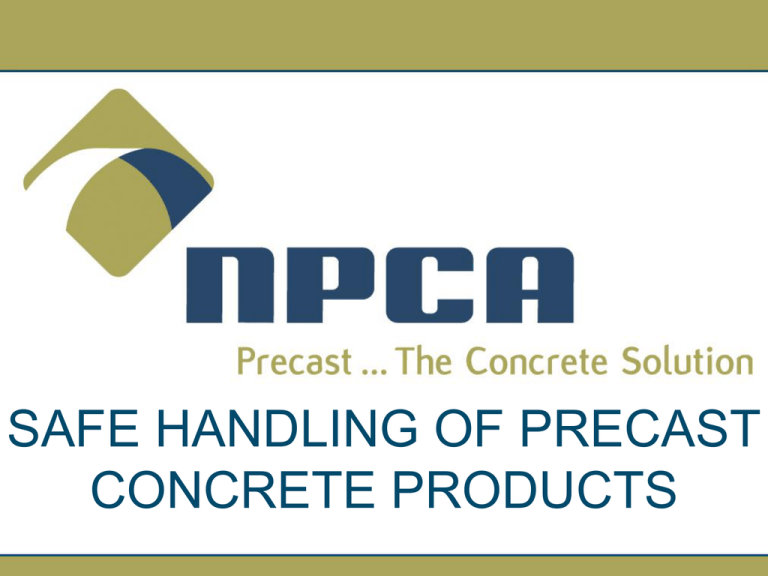
SAFE HANDLING OF PRECAST CONCRETE PRODUCTS Safety Handling of Precast Concrete Products • The lifting of any precast product requires the use of special equipment and substantial planning and knowledge. • All of this equipment interacts with one another to allow for safe and effective lifting of a product. • Any failure of any one component could lead to an unsuccessful lift with potential devastating effects to the product, human life or other items in the surrounding environment. A SAFE LIFT RELIES ON MANY “CRITICAL POINTS” Components of a Safe and Successful Lift • Lifting Equipment – Overhead Crane, Forklift, Travel Crane, etc. • Lifting Anchors and Shackles – Swift lift pins, utility anchors, cable hooks, etc. • Rigging Equipment – Lifting Bars, Straps, Chains, Cables, Slings, Hooks, Clevises, etc. • Concrete Product – concrete weighs about 4,000 lbs/yd3. Lifting Equipment OSHA Standard 1910.179 Overhead Cranes • Typical cranes in precast plants include overhead cranes, gantry cranes and/or jib cranes. • Such cranes are subject to OSHA’s General Industry Standards and as such, you should be aware of the following requirements. Lifting Equipment Crane Requirements 1. Operators must be trained and designated by the company; 2. Rated Load of the Crane must be plainly marked on each side of the crane, legible from the working level; NEVER EXCEED THE LOAD RATING!!!! Lifting Equipment Crane Requirements 3. Frequent Inspections - visual exams by operator or designated person with records not required. Normal service - monthly; Heavy service - weekly to monthly; Severe service - daily to weekly. – Performed on all operating mechanisms, hooks and chains. Check operation items such as brakes, limit switches, pendant control, etc. Lifting Equipment Crane Requirements 4. Periodic Inspection – documented, visual inspection by appointed person who makes records of apparent external conditions to provide the basis for a continuing evaluation. Normal service - Annual; Heavy service - Semi-Annual; Severe service - Quarterly; Lifting Equipment Crane Requirements 4. Periodic Inspection (cont) - All components such as loose bolts or rivets, worn sheaves or drums, cracked or distorted parts, excessive wear, etc. NOTE: The inspector will determine if disassembly is warranted by visual conditions noted during inspection. Lifting Equipment OSHA STANDARD 1910.178 Powered Industrial Trucks Forklift Operator Training DO NOT operate a forklift unless authorized by and trained by your employer!! The employer shall ensure that each powered industrial truck operator is competent to operate a powered industrial truck safely, as demonstrated by successful completion of the training and evaluation specified in the OSHA standard. Training must be completed prior to initial operation of equipment and recertified at least every 3 years thereafter. Retraining should also occur if an operator has an accident or is observed operating equipment in an unsafe or improper manner. Training must be equipment specific. Specialized Forklift Equipment for Precast Industry • Spreader bars are commonly used to lift precast products in tandem with cranes and/or forklifts – spread lifting cable or chain to required lifting width. • Booms are often attached to forklifts to lift and handle products. Specialized Forklift Equipment for Precast Industry • Any mechanism used in tandem with a forklift/crane to accomplish a lift must be designed and rated by a competent person (ie. P.E.) and be appropriately labeled. • Need forklift manufacturer to approve an attachment device such as a boom – in writing! Specialized Lifting Equipment Components of a Safe and Successful Lift Lifting Equipment – Cranes and Forklifts. Lifting Anchors and Shackles – Lift pins, utility anchors, cable hooks, etc. Lifting Anchors • Various types available and in use within the precast industry. • Follow Manufacturer’s recommendations for placement and loading limitations. • The rated working load of an anchor is dependent on: – Proper location of the lifting anchor within the concrete product (edge distance); – Concrete Strength. Selection of Lifting Anchor When selecting lifting hardware, plan for the “effective weight” of a lift, not the actual weight of the product. When a Fleet Angle of 120 degrees is used to lift a load, the effective weight of a load is double the actual load weight. Therefore, a load weighing 10,000 pounds has an effective load weight of 20,000 pounds. Adequate lifters and lifting chains/cables must be planned for a 20,000 pound lift. Selection of Lifting Anchor and Lifting Chains When using a 30 degree fleet angle, the effective load weight is 4% more than the actual load weight. When using a 60 degree fleet angle, the effective load weight is 14% more than the actual load weight. When using a 90 degree fleet angle, the effective load weight is 30% more than the actual load weight. Lift Pins Lift Pins • Require a Shackle to lift with hook. Specific shackles “mate” with each size lift pin. Lift Pins Cast into Product Lift Pins Cast into Product • Note that the pins are located at adequate edge distances. • If unsure of pin placement, see your supervisor and/or seek advice from the manufacturer.. Lift Pins Cast into Product • Ensure proper placement of pins so that adequate concrete strength surrounds the pins. • Know how the product will need to be lifted in order to help determine pin location. Four pins cast into product Lift Pins Cast into Product • The lift chain was “choked” to accommodate overhead limitations creating more lateral force on pins. • Side pulling from the excessive sling angle put stress on the concrete surrounding the lift pin • Result – damaged product and possible pin failure. Pin location Utility Anchor or Lifting Cable Does not require a shackle, but requires a larger edge clearance to embed the anchor into the structure. NOTE: Chain rubbing concrete may cause damage to chain and concrete. Requires concrete around anchor Pictured are utility anchors Components of a Safe and Successful Lift Lifting Equipment – Overhead Crane, Forklift, Travel Crane, etc. Lifting Anchors and Shackles – Swift lift pins, utility anchors, cable hooks, etc. Rigging Equipment – Lifting Bars, Straps, Chains, Cables, Slings, Hooks, Clevises, etc. OSHA Compliance for Rigging Hardware Rigging equipment shall not be loaded in excess of its recommended safe working load Types of slings covered are those made from alloy steel chain, wire rope, metal mesh, natural or synthetic fiber rope (conventional three strand construction), and synthetic web (nylon, polyester, and polypropylene). Inspections – Daily visual before being used – Documented Periodic Inspections conducted at a frequency based on severity and frequency of use. At least every 12 months. – Damaged or defective slings shall be immediately removed from service and either destroyed or marked “Danger - Do Not Use”. 1926.251(b) Alloy steel chains. (1) Welded alloy steel chain slings shall have permanently affixed durable identification stating size, grade, rated capacity, and sling manufacturer. Such tags require wire brushing on occasion for visibility of markings Inspection Items INSPECT FOR: 1. Excessive Wear (Max 10% reduction allowable or 2 critical areas with 5% reduction). Check at load bearing points; 2. Throat Opening (Max increase of 15%); 3. Twisting (Max 10 degrees from unbent hook plane) and Deformation; 4. Cracks, Nicks, Gouges; 5. Evidence of Heat Damage. Safety Latches Required on Load Block Hooks, Hoists and Chain Falls. Wire Rope Inspections Paint To Paint = 1 Lay 1 Lay Strands in the wire rope are the individual groups of wires that rotate around the center. Remove from service if: 10 randomly broken wires in one rope lay 5 wires in one strand in one rope lay REMOVE IF THESE CONDITIONS ARE FOUND! Kinking Bird Caging Lifting Chains • Chains used to lift product must be of lifting grade material. • Grade 80 or 100 alloy only – Grade 100 is the strongest chain alloy and gives higher chain strengths than Grade 80. • NEVER use other chains such as “towing” chains or “tie down” chains for lifting! Lifting Strength Concepts • The optimum capacity of a chain or wire rope is when it is used at a 90 degree angle to the load. • The Working Load Limit (WLL) marked on the tag is based on a 90 degree lift. Chain Load 90 degree angle Lifting Strength Concepts • The actual lifting strength of a chain or cable is reduced when the angle between the load and lifting chain/cable is less than 90 degrees. Fleet Angle Load Chain/Cable to load angles are less than 90 degrees Lifting angles reduce working load limits of slings NOTE: The Working Load Limit of a Triple Chain Sling and Quad Sling is 50% more than a double chain sling of the same grade and link size and equal distribution on each leg (based on center of gravity). Reduction of Working Load with Varying Lifting Angle Percentage shown are of the maximum Working Load Limit of chain 60 o 45 o 30° 50% Maximum Working Load Limit of chain 86 1/2% 70% Normal Working Load Limit of a Standard sling How does off-center “tip loading” affect working loads True Loading 1/4 in. Off Center 15,000 lbs. 13,000 lbs. 100% of Rating 88% of Rating 1/2 in. Off Center 11,800 lbs. 79% of Rating 3/4 in. Off Center 10,650 lbs. 71% of Rating Point Loading 6,150 lbs. 41% of Rating “The Weakest Link” • Remember, the maximum amount you can lift safely is determined by the “weakest link” in the lift sequence. – The lift mechanism cast into a structure may be the weakest link. – The forklift, crane or other equipment used to perform the lift may be the weakest link. – A single chain link or hook may be the weakest link. – The Concrete Strength may be the weakest link. Yarding Product According to the National Precast Concrete Association, product must be yarded on a flat, even surface. Dunnage must be adequate to support the weight of the product. Yarding Product • Fifth Point Rule – on a flat slab, locate substantial wood blocks at both ends of slab at a distance of 1/5 of overall slab width from outside edge. 15 ft. 3 ft. Yarding Product Front View of End Wall Lifter Location Lifter Location Locate blocking under Lifters on odd shaped product, since lifters should be placed to find center of gravity. Product was blocked under lift pin locations FINAL DISCUSSION • KNOW THE STANDARDS THAT APPLY TO YOUR COMPANY’S LIFTING PRACTICES. • DO NOT LIFT OR TRANSPORT PRODUCT UNLESS TRAINED AND AUTHORIZED BY YOUR COMPANY. • SEEK ASSISTANCE AS NECESSARY. QUESTIONS?
